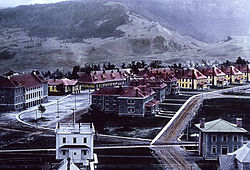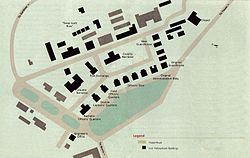Fort Yellowstone | |
 Fort Yellowstone, circa 1910 | |
 Fort Yellowstone map | |
| Location | Yellowstone National Park, Park County, Wyoming, United States |
|---|---|
| Nearest city | Gardiner, Montana |
| Coordinates | 44°58′30″N 110°41′53″W / 44.97500°N 110.69806°W |
| Built | 1891 |
| Architect | US Army Chief Quartermaster, Dakota; Reed and Stem, Robert Reamer |
| Architectural style | Colonial Revival |
| NRHP reference No. | 03001032[1] |
| Significant dates | |
| Added to NRHP | July 31, 2003 |
| Designated NHLD | July 31, 2003[2] |
Fort Yellowstone was a U.S. Army fort, established in 1891 at Mammoth Hot Springs in Yellowstone National Park. Yellowstone was designated in 1872 but the Interior Department was unable to effectively manage the park. Administration was transferred to the War Department in August 1886 and General Philip Sheridan sent a company of cavalry to Mammoth Hot Springs to build a cavalry post. The army originally called the post Camp Sheridan in honor of General Sheridan but the name was changed to Fort Yellowstone in 1891 when construction of the permanent fort commenced. The army administered the park until 1918 when it was transferred to the newly created National Park Service. The facilities of Fort Yellowstone now comprise the Yellowstone National Park headquarters, the Horace Albright Visitor Center and staff accommodations.
Between the years 1891 and 1913, a total of 60 structures were made at Fort Yellowstone, of which 35 were still in existence one hundred years later. The fort was built in two major construction waves. During the first construction period from 1891 to 1897, mainly wood-framed buildings in what has been referred to as "cottage style" were built. A few of them had Colonial Revival architectural elements. A second construction wave began in 1908 and concluded in 1913. These structures were primarily built from locally quarried sandstone. Many of the structures from the later construction period are now used as administrative offices, residences for National Park Service employees, museums and visitor center. Beyond the immediate confines of the fort, cabins were constructed for use by small detachments of army personnel while on patrol throughout the park.
Besides the buildings of Fort Yellowstone, the army left a legacy of policies and practices that served as precedents for the future National Park Service management of national parks. The army military commanders implemented backcountry patrols, wildlife protection and management, and protection of natural features. Army educational programs were later adopted by the National Park Service as part of their resource management. The army effectively implemented law enforcement priorities and developed a ranger force that provided for prosecution and punishment of those engaged in illegal activity in the national parks. The National Park Service carried over a version of the campaign hat worn by members of the army during the last years of their management of Yellowstone National Park for use by Park Rangers.
- ^ "National Register Information System – (#03001032)". National Register of Historic Places. National Park Service. November 2, 2013.
- ^ "Fort Yellowstone". National Historic Landmark Program. National Park Service. Archived from the original on 2012-07-28. Retrieved 2013-01-25.